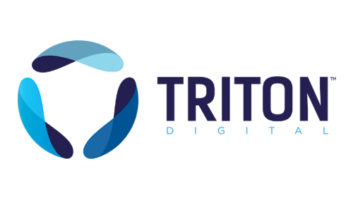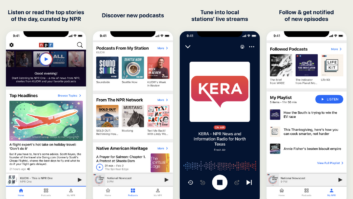
What’s in store for the radio industry in 2018? Over the last few weeks, we’ve publishing a series of interviews with thought leaders from around the globe in various segments of our business. We ask them to weigh in about specific trends and stories they’ll be watching this year. Thomas Hjelm is chief digital officer for NPR.
Radio World:What do you see as the most pressing technology challenge facing public broadcasters?
Thomas Hjelm: Challenges and opportunities come in pairs. The continuing boom in podcast and on-demand listening has brought new audiences, new voices, new revenue to public radio. And NPR, WNYC, “This American Life,” Radiotopia, WBUR and APM, among others, continue to top the charts. On the other hand, the public radio model is built around direct audience engagement. It’s key to our impact in the public forum and core to our business model.
As our content continues to go wide, on new platforms and devices and through new channels and partnerships, we need to make sure the connection remains vital, that the audience knows who we are and we know who they are.
RW:What consumer electronics trends will have the most impact on how consumers interact with radio and audio media?
Hjelm: Smart speakers, smart speakers and smart speakers. The voice-activated transformation is here, it’s real, and with every month we see its reach and impact expand. The number of households with a smart speaker more than doubled in 2017, and according to a study conducted by NPR and Edison, about 85% of respondents said that once they started using Alexa or Google Home, there was no going back. It’s became their listening device of choice. Fortunately, the smart speaker also speaks to public radio’s strengths: we do live and we do on-demand, long-form and short-form; we’re in the moment and we have a deep audio archive; and the voices of public radio are what I think Siri and Alexa aspire to be: your daily audio companions. This new frontier opens up all sorts of possibilities for us to renew our relationship with audiences.
RW:What other technology trends or changes should we be watching for in public media and/or digital content?
Hjelm: Two trends we’re very attentive to are the evolution of audio delivery and the latest developments in crowdfunding and subscription models.
As I said, podcasts have become a huge part of public radio’s value proposition, but in short order the downloading of an audio file will give way to streaming, which in turn will provide producers with new insights to listening patterns as well as new lines into selling and tracking sponsorships.
As for revenue, Kickstarter and Patreon, among others, are at the center of a technical and cultural phenomenon that has its roots in the membership model of public broadcasting. While public radio audiences continue to support their local stations in record numbers, generations and habits are changing, and so we need to find a way to reimagine membership. NPR is itself not donation-supported — it’s the stations that own the membership model — but we’re partnering with them in this effort.
RW:Do you have advice for how smaller media organizations can learn from NPR’s efforts to marry technological advances to the traditional strengths of broadcast radio?
Hjelm: NPR invests a great deal in digital platforms and products and innovation, but we put far more resources into our newsroom and program development. And that’s the right proportion. Put your chips on finding and training and celebrating unique voices, telling the stories that no one else is telling, informing and inspiring — in the end, these are what will distinguish any media company large or small.
I think it’s also important to keep an eye on the “brand permission” that your audiences give you. From the perspective of a legacy media company, I find that so much of looking ahead requires looking within to identify the core values that you made you special in the first place. For public radio, those values would include great storytelling and audio experiences, the power of a national-local news network, the membership model. Innovation means renewal of those values by adapting to new trends and technologies.
RW:How do you think your personal media and technology habits mirror or differ from those of audiences you’re attempting to reach in your role as chief digital officer?
Hjelm: NPR and member stations have to address the needs of our current audience at the same time that we anticipate and adapt to the behaviors of new ones. We need to be bilingual, in other words, so I spend maybe a third of my listening time with the live radio, the rest listening to podcasts or other on-demand formats through as many devices and platforms as possible.
With the media marketplace being so cluttered, the discovery of content is also a chronic challenge. How do people find us? Or not find us? Often, I’ll pretend I’m a nonloyalist customer who is looking for a given public-radio story, or wants to share something, or donate money, and then I look at how smooth the journey was — or wasn’t.
RW:Where do you learn about new technology each year, what trade shows or information sources?
Hjelm: I’m writing this en route to CES, so there’s that. I read the main tech blogs, partly for new information and partly for the popular take (right or wrong) on that information. Among newsletters, Stratechery, Hot Pod, Podnews and of course eMarketer are helpful.
But nothing rivals direct interaction with experts. First, I always look to my department for education. Our design team, for example, maintains a terrific blog: https://npr.design. Second, when I was with New York Public Radio, we had an advisory group comprising leaders from the city’s tech, media, VC, marketing and consulting communities. Their advice and insights were invaluable. I’m now doing something similar at NPR.
RW:What else should readers keep on their radar?
Hjelm: The current cultural movement in the workplace — the “reckoning” in the wake of harassment stories — is obviously something we’re all attuned to. As we’ve been working through our own issues here at NPR, and looking at ways to address issues of trust, communication and authority, I’ve been struck by how the digital team has applied principles of problem-solving and teamwork to the larger conversation.
It’s a digital team’s job to be at the frontline of looking at ways to meet the changing needs of audiences. They can help an organization change a workplace culture, too.












